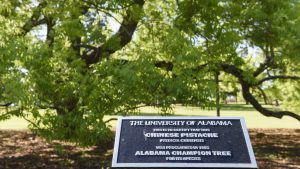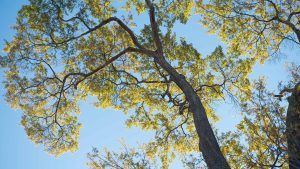
For the fifth consecutive year The University of Alabama has earned the distinguished recognition of “Tree Campus USA.”
The designation comes with a plaque that will be placed in the lobby of Rose Administration building where previous years’ Tree Campus USA plaques are on display.
“Tree Campus USA, an Arbor Day Foundation program, honors colleges and universities and their leaders for promoting healthy trees and engaging students and staff in the spirit of conservation,” said Lauren Weyers, program coordinator of the Arbor Day Foundation.
“If ever there was a time for trees, now is that time. Communities worldwide are facing issues with air quality, water resources, personal health and well-being, and energy use. The University of Alabama is stepping up to do its part. As a result of your commitment to effective urban forest management, you are helping to provide a solution to these global challenges.”
Donna McCray, senior director of facilities operations and grounds use permits at UA, said the University’s facilities operations and grounds department works hard to keep the campus of the Capstone beautiful, and the University’s 10,000 trees are a major contribution to that.

“We’re extremely honored and proud to be named a Tree Campus USA for another year,” McCray said. “We love the campus canopy and it’s our goal to keep it healthy and beautiful for generations of students, faculty, staff, visitors and the campus community to enjoy.”
To obtain this distinction, which is only given to accredited colleges and universities, UA met the five core standards for sustainable campus forestry required by Tree Campus USA:
- Establishment of a tree advisory committee.
- Evidence of a campus tree-care plan.
- Dedicated annual expenditures for its campus tree program.
- An Arbor Day observance.
- The sponsorship of student service-learning projects.
McCray said UA’s 2020 Arbor Day Celebration will be held on April 24 at 2 p.m. at the Aquatic Center, where the grounds team recently relocated a mature magnolia tree, saving it from a construction area.
The Capstone’s urban forest is comprised of more than 60 types. McCray said oaks and magnolias are the most prevalent, and a Chinese pistache tree, which was a gift from the queen of England in the mid-1800s, is the rarest.
Contact
Jamon Smith, Strategic Communications, jamon.smith@ua.edu, 205/348-4956
Source
Donna McCray, dmccray@fa.ua.edu, 205/348-6777
